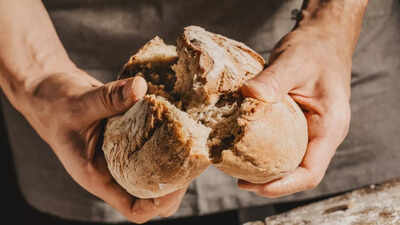ARTICLE AD BOX

They’ve yet to discover a pool where the water transforms into wine in just one touch — but imagine uncovering a loaf of bread baked 1,300 years ago, still bearing the face and message of Jesus Christ! That’s exactly what happened at an archaeological site in southern Turkey — five small round loaves from the 7th-8th century C.E.
were found, one stamped with Christ as the sower and a Greek inscription reading “With our gratitude to Blessed Jesus.”Now, the historical curiosity is justified — how were the early days of Christian lives, what were the rituals like, what did they eat, how did they use bread? However, another matter has captured the internet’s attention: How did they make such a bread that lasted — not a week, or a month, or even a year — but over a millennium?
The bread that carried faith
Archaeologists working at Topraktepe (ancient Eirenopolis) in Turkey’s Karaman Province uncovered five carbonized loaves, dated to the 7th-8th centuries C.E.
Among them, one loaf is particularly notable, as it features a depiction of Jesus not in the usual majestic iconographic form — but as a sower or farmer, accompanied by the Greek inscription “With our gratitude to Blessed Jesus.”The others bear Maltese-cross motifs, suggesting they were used in Christian ritual — likely early communion bread (Eucharistic use) rather than everyday loaves. However, beyond this imagery, what has captured our attention is the preservation: it’s remarkable — the loaves were carbonized in a fire and then buried in a low-oxygen environment, allowing their form, reliefs, and inscriptions to survive intact for over a millennium.
Now that curiosity has been quenched — to some extent — the question arises: How to make a bread that lasts for days (at least 10 days)?
Bread that lasts: Baking 101
While we may not need our bread to survive a millennium, there are meaningful lessons and practical techniques to extend freshness. Here are some tips:Choose the right flour and method: The magic is in the flour! Using part-whole-grain flour or longer fermentation can significantly help the bread’s shelf life.
In fact, replacing part of the white flour with darker flour helps the loaf hold up a few days longer. Moreover, starting your dough with a sponge (flour + water + yeast left overnight) improves fermentation and flavor — and can extend shelf-life up to a week or more. Additionally, techniques like the tangzhong or water-roux method (humid gel of flour and liquid at around 65°C) help retain moisture and slow staling.Bake properly and cool before storing: Balancing the temperature is key to a good bread. Allow the loaf to cool fully before cutting or wrapping — it helps stabilize the crumb and prevents the crust from becoming soggy or the interior from losing moisture.
Exactly how bread from the 7th century was baked has yet to be fully studied, but the carbonization hints at very dry conditions and strong heat.Store smartly: Once you’ve aced making soft, fluffy, and fresh bread, make sure to store it at room temperature in a breathable bag or linen bag rather than the fridge. This might sound surprising and somewhat odd, but refrigeration actually accelerates staling by causing starches to recrystallize.
On the other hand, using linen or cotton bread bags (or even wrapping in parchment and then putting into a bag) helps maintain a good moisture balance.
For long-term keeping, slice the bread and freeze individual portions. Here as well, freezing is far better than the fridge for long storage. Consider preservation-friendly additions: If you’re baking bread at home, adding small amounts of natural humectants (e.g.,
honey instead of sugar) or using longer fermentation (sourdough) might help the loaf resist going stale quickly.We always tend to look at the ancient masters and pick up pieces that might fit into the puzzle that modern living is. Whether it’s trying to air-condition without the air-conditioner, or keep the drinking water cool without refrigeration. Bread-making has come a long way, thanks to technological innovations and advancements. But baking a bread that lasts through a millennium? That seems unlikely even for a cutting-edge machine!But maybe with some simple, homely hacks, one can make a bread that lasts days — at least a week? Why not try and test if it works!

 2 hours ago
4
2 hours ago
4









 English (US) ·
English (US) ·